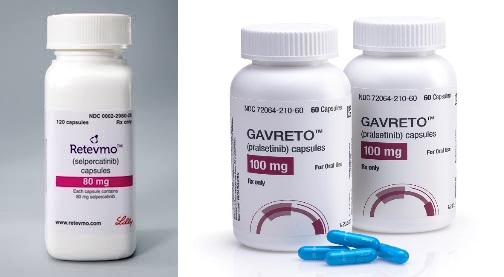As Roche’s Gavreto (pralsetinib) won the regulatory nod following Lilly’s Retevmo (selpercatinib) in March, the two RET (rearranged during transfection) targeted therapies are likely to compete in the Korean market.
However, for the two treatments to be used for cancer patients regardless of cancer type, the nation will have to universalize diagnostic tests, including next-generation sequencing.

On March 11, the Ministry of Food and Drug Safety authorized the use of Lilly’s Retevmo in adult patients with metastatic RET fusion-positive non-small cell lung cancer (NSCLC), adults and pediatric patients 12 years of age or older with advanced or metastatic RET-mutated medullary thyroid cancer requiring systemic therapy, and adult patients who are refractory to radiation iodine and who have prior sorafenib and/or lenvatinib treatment, or adult patients with advanced or metastatic RET-fusion benign thyroid cancer who require systemic therapy.
On Tuesday, the MFDS approved Roche’s Gavreto to treat adult patients with RET fusion-positive locally advanced or metastatic NSCLC and adult patients with RET-mutated locally advanced or metastatic medullary thyroid cancer requiring systemic therapy.
The permits for the two therapies were based on their response rates and duration of response in phase 1/2 trials. RET-mutated cancer patients received chemotherapy because there were no other anticancer options.
The approval for Retevmo was based on the LIBRETTO-001 trial in RET-mutated advanced or metastatic solid cancer patients.
Metastatic RET-fusion positive NSCLC patients who had never received platinum chemotherapy showed an 85 percent response rate in Retevmo treatment.
The license for Gavreto was based on the ARROW trial in RET-mutated advanced or metastatic solid cancer patients.
Gabreto’s response rates were 57.5 percent, 58.2 percent, and 70.4 percent in RET-fusion positive locally advanced or metastatic NSCLC patients with prior platinum chemotherapy, those with prior systemic therapy treatment-naive patients, respectively. The median duration of response was 17.1 months, 17.1 months, and nine months, respectively.
In the competition between Retevmo and Gavreto, Retevmo has an advantage in indications and target population.
This is because Retevmo has an additional indication for RET fusion-positive thyroid cancer. It has a broader patient population, including pediatric patients aged 12 or more for the treatment of medullary thyroid cancer.
However, both treatments require a verified and reliable diagnostic method to select RET-gene fusion or mutation patients.
In clinical trials of these two drugs, researchers used NGS the most when diagnosing patients. NGS is a suitable biomarker test that can detect RET gene fusion and mutation simultaneously.
Thus, for the two drugs to be used for clinical care, observers said NGS should be universalized in the local cancer diagnosis and treatment environment.

